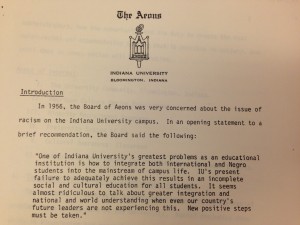By: Sarah Kissel, Bicentennial Intern, Class of 2017, Political Science, Religious Studies, English Literature, Bloomington
“Racism and Race-Awareness at Indiana University – Bloomington: An Ad Hoc Study by the Board of Aeons. February 23, 1982.” Thus reads the title of the iconic report on race relations at Indiana University, a decades-long conversation among members of the Board of Aeons that began with questions regarding minority student retention, which persisted into the later years of the eighties.
The report opens with a quote highlighting the integration of “both international and Negro students into the mainstream of campus life” as one of Indiana University’s “greatest problems.” The 1982 student authors continue: “Today the Board unanimously stands firm on the grounds that racism should not be allowed to exist at Indiana University. Although we don’t believe that racism is as overtly present as it was in 1956, it is still in existence at Indiana University.”
It has been said that the Board, while consistently striving to approach issues with a wide lens and future-oriented mindset, is very much a product of its time. The acknowledgement of persistent racist attitudes toward black students is predictable to an extent, and extending that critical eye to the experiences of international students results in a conversation still held today.

The 1982 Board then turns its attention to six areas of interest: The University Community of Bloomington Indiana, American Culture, Minority Recruitment Programs, the Fraternity System at IU, Cultural Awareness in the Classroom, and Integration in Programs and Organization Outreach Efforts.
One of the many recommendations found in the report is an American Culture Option Requirement, a group of classes on American culture from which freshmen would be required to select a course on “Afro-American Studies, American Indian Heritage, Latino Heritage, Women’s Studies, History of Racism, Racial Sensitivity, or a survey on all American cultures.”
Of the six sections and multiple suggestions therein, the portion that is most apparently translated into an action plan is that on “direct minority recruitment to the more exceptional educationally motivated High School Seniors” and “place minority recruitment higher on the list of priorities by which the Admissions Office operates from.” The 1987-88 Board revisited the issue of racism and “race-awareness” at IU under the heading “minority student retention” as their third-top priority as the school year opened. This prioritization was translated into a subcommittee throughout the fall of 1987 and rapidly produced a report by Thanksgiving.
Throughout the semester, meetings with Vice President Gros Louis revealed that the Board was encouraged to revisit the issue by the administration — a rare move according to typical proceedings. On November 30th 1987, the Board met with Dr. Louis for a discussion on the various subcommittees, at which he revealed that, following the 1982 report, financial aid funds for minority students had been put in place but were going unused. Furthermore, he informally unveiled plans for a $2 million Minority Achievers program.
The Board’s 1982 report “Racism and Race-Awareness at Indiana University – Bloomington: An Ad Hoc Study” prompted both student and administrative attention and action toward the issues of racism on IU’s campus. Though this decade certainly does not lay the issue to rest by any means, it is out of the eighties that the Board of Aeons makes significant strides toward improving the campus experience for minority students.
Read more about the Board of Aeons decisions here: